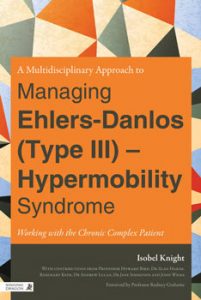 “A Multidisciplinary Approach to Managing Ehlers-Danlos (Type III) – Hypermobility Syndrome: Working with the Chronic Complex Patient”
“A Multidisciplinary Approach to Managing Ehlers-Danlos (Type III) – Hypermobility Syndrome: Working with the Chronic Complex Patient”
Isobel Knight
ISBN: 978-1848190801
Jessica Kingsley Publishers
This book is about a multi-disciplinary approach to managing multi-systemic conditions such as ED-S Type III now known as Hypermobility Syndrome.
The six types of Ehlers-Danlos Syndrome are listed at the back of the book. It also refers to joint Hypermobility Syndrome, Fibromyalgia and Chronic Pain. That is, multi-systemic conditions in relation to the fact that many professionals are involved. It is often professionals from different disciplines who struggle to communicate with each other.
The author talks from an auto-ethno-graphical approach which is defined as a writing that connects the personal experience to the cultural and places the self within the social context. That means it is usually written in the first person and involves writing from one’s own experience but actually for academic purposes so that it can inform professionals.
The book talks about the wide range of psychological and physiological implications of such conditions and also the final part is about exercise and rehabilitation.
There are a number of appendices including useful contacts, goal settings, what to expect from physiotherapy but also the diagnostic criteria for Hypermobility Syndrome, the five questions that are asked which I will put in this review as this may be of relevance to individuals who have connections with our service.
- Can you now or could you ever place your hands flat on the floor without bending your knees
- Can you now or could you ever bend your thumb back to touch your forearm
- As a child did you amuse your friends by contorting your body into strange shapes or could you do the splits
- As a child or teenager did your shoulder or knee dislocate on more than one occasion
- Do you consider yourself to be double jointed
It also then looks at the Beighton score with illustrations. The scoring system involves the following:
- Can you put your hands flat on the floor with your knees straight.
- Can you bend your elbow backwards
- Can you bend your knee backwards
- Can you bend your thumb back on to the forearm
- Can you bend your little finger up at 90 degrees right angles to the back of your hand
This is a well written book that is very clearly referenced and is not only the experiences of the author who has the Syndrome herself but has a number of experienced and reputable contributors from the field of Rheumatology, Physiotherapy, Health Psychology, the Bowen Technique, the Feldenkrais and a contemporary dancer who has a Masters in advanced professional practice in the school of Integrated Health.
Consultant Clinical Psychologist
& Director of Axia ASD Ltd.







Leave a Reply